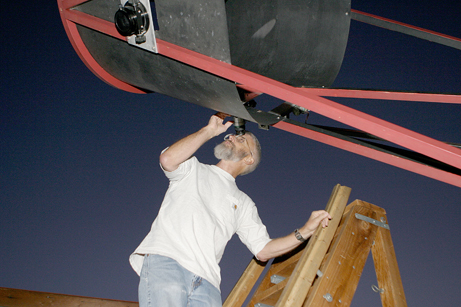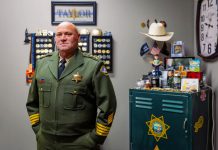
Fremont Peak Observatory celebrates 20 years
On Fremont Peak, as the sun begins to set and the skies darken,
stars, planets and satellites slowly unveil themselves to the
curious stargazers on Earth. Some can be seen by the naked eye;
others through binoculars and some require high-powered
telescopes.
But last week the annual Perseid meteor shower returned and put
on a show for the amateur astronomers at Fremont Peak State
Park
– a hands-down favorite spot for stargazing in San Benito
County.
Fremont Peak Observatory celebrates 20 years
On Fremont Peak, as the sun begins to set and the skies darken, stars, planets and satellites slowly unveil themselves to the curious stargazers on Earth. Some can be seen by the naked eye; others through binoculars and some require high-powered telescopes.
But last week the annual Perseid meteor shower returned and put on a show for the amateur astronomers at Fremont Peak State Park – a hands-down favorite spot for stargazing in San Benito County.
A short hike from the State Park’s camping grounds, a small brown building sits on a hilltop overlooking San Juan Canyon. From the outside, the building is ordinary. But when visitors step inside they find that the space in one of the rooms is mostly taken up by a 30-inch f/4.8 telescope. The telescope requires a ladder up to the eyepiece and the roof of the building can be rolled back to reveal the darkening sky as twilight approaches with what one observatory member called “an upside-down garage door.”
Pat Donnelly, the president of the Fremont Peak Observatory Association, gives credit for the building of the observatory to those who came before him, specifically Kevin and Denni Medlock.
“It was their idea for the observatory,” said Donnelly, who has been president since 2001. “I was a late-comer. The work was done well before me.”
Fremont Peak had been a popular location for astronomers from all over the Bay Area for decades, Donnelly said.
In the lecture room of the observatory, a small room that seats 20 people, Donnelly pointed out photographs of volunteers working to build the wooden building and of Kevin Medlock building the telescope.
Donnelly, who has traveled the world in search of stars, discovered the observatory shortly before the telescope was completed.
“I went with a friend in 1986,” Donnelly said. “An image of Saturn is the first thing this telescope saw.”
Since the completion of the astronomer’s haven in 1986, members of the Fremont Peak Observatory Association – who range from trained physicists to amateur astronomers – share their knowledge of the skies with visitors.
Public programs are offered from April to October, with some special programs in the winter months.
On a recent Saturday evening, though they had not planned a public program, Donnelly and FPOA member Ron Dammann gathered at the observatory just before sunset, hoping to catch a glimpse of the annual Perseid meteor shower, which passed overhead Aug. 11-14.
The two allowed campers who had wandered up to the observatory to look through the telescope and pointed out items with a green laser pointer. One impressive view of the night included the globular cluster M-22, one of the “objects” on Donnelly’s list to view before the meteor shower passed overhead after 11 p.m. The cluster is home to more than 100,000 stars. Other sites of the night included more familiar objects such as the Big Dipper, other constellations and Jupiter and its four moons.
Dammann, the director of equipment for FPOA, has been involved with the FPOA for 10 years. A San Jose resident, he spends many of his weekends at the observatory in San Juan, and joked that his title means he is in charge of fixing things.
“It’s a chance to show other people what’s visible,” Dammann said. “You can see things that are millions of light years away and hear the cows in the background.”
The first time Dammann visited Fremont Peak, he told his wife it was the kind of group he’d like to join because of the chance to teach others.
Donnelly signed up for FPOA for much the same reason – a chance to share his passion for space with others.
Donnelly becomes animated when he talks about astronomy, his eyes lighting up as they might have when he first discovered the world outside our atmosphere nearly 50 years ago.
“I was reading a fourth-grade science book and it said you can see the planets with the naked eye,” Donnelly said. “Venus was visible at that time.”
For him, the fun and the science of astronomy have always gone hand in hand.
“The fun of it seemed to enhance the science,” Donnelly said, who eventually studied as physicist.
But sometimes, as when the meteor shower began its lightshow Saturday night, it’s all about the beauty in the skies.









